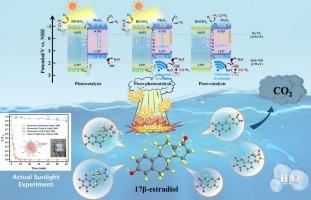Synergistic piezoelectric effect and oxygen vacancies in MoS2/BiOIO3 heterojunctions boosting photocatalytic degradation of 17β-estradiol
IF 13.2
1区 工程技术
Q1 ENGINEERING, CHEMICAL
引用次数: 0
Abstract
Insufficient separation of photogenerated charges significantly hinders the development of semiconductor-based photocatalytic technologies. Coupling piezoelectric Coupling piezoelectric effects with oxygen vacancies (OVs) effectively promotes bulk charge separation, enhancing photocatalytic removal of emerging contaminants. MoS2/BiOIO3 (MBI), a II-scheme heterojunction material with OVs, was synthesized via a simple hydrothermal method. Combining experimental investigations with density functional theory (DFT), we delved into the redox mechanisms of 17β-estradiol (17β-E2). The results demonstrated 91.4 % degradation of 17β-E2 by MBI-5 % within 15 min under photocatalysis. When applying piezo-photocatalysis, nearly 100 % degradation was achieved in the same duration. The reaction rate constant was 1.69 times that of the photocatalysis alone. The significant performance enhancement is attributed to the synergistic effects of the piezoelectric effect and OVs. Additionally, DFT analysis identified the vulnerable sites of 17β-E2 and revealed potential degradation pathways. Finally, the application experiments with distinct focuses further validated the superior performance of MBI nanomaterials. This study provides a reliable reference for applying piezoelectric photocatalysts with OVs to treat water environment contaminated by emerging pollutants.

MoS2/ bioo3异质结的协同压电效应和氧空位促进了17β-雌二醇的光催化降解
光生电荷的分离不足严重阻碍了半导体光催化技术的发展。耦合压电与氧空位(OVs)的耦合压电效应有效地促进了体电荷分离,增强了光催化去除新兴污染物的能力。采用简单的水热法合成了具有OVs的ii型异质结材料MoS2/BiOIO3 (MBI)。结合实验研究和密度泛函理论(DFT),探讨了17β-雌二醇(17β-E2)的氧化还原机制。结果表明,在光催化作用下,MBI-5在15 min内对17β-E2的降解率为 %,降解率为91.4 %。当应用压电光催化时,在相同的时间内降解率接近100% %。反应速率常数为光催化反应速率常数的1.69倍。这种显著的性能增强归因于压电效应和OVs的协同效应。此外,DFT分析确定了17β-E2的易损位点并揭示了潜在的降解途径。最后,各有侧重的应用实验进一步验证了MBI纳米材料的优越性能。该研究为应用压电光催化剂处理新兴污染物污染的水环境提供了可靠的参考。
本文章由计算机程序翻译,如有差异,请以英文原文为准。
求助全文
约1分钟内获得全文
求助全文
来源期刊

Chemical Engineering Journal
工程技术-工程:化工
CiteScore
21.70
自引率
9.30%
发文量
6781
审稿时长
2.4 months
期刊介绍:
The Chemical Engineering Journal is an international research journal that invites contributions of original and novel fundamental research. It aims to provide an international platform for presenting original fundamental research, interpretative reviews, and discussions on new developments in chemical engineering. The journal welcomes papers that describe novel theory and its practical application, as well as those that demonstrate the transfer of techniques from other disciplines. It also welcomes reports on carefully conducted experimental work that is soundly interpreted. The main focus of the journal is on original and rigorous research results that have broad significance. The Catalysis section within the Chemical Engineering Journal focuses specifically on Experimental and Theoretical studies in the fields of heterogeneous catalysis, molecular catalysis, and biocatalysis. These studies have industrial impact on various sectors such as chemicals, energy, materials, foods, healthcare, and environmental protection.
 求助内容:
求助内容: 应助结果提醒方式:
应助结果提醒方式:


